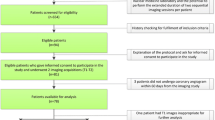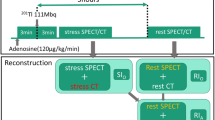Abstract
Purpose
IQ-SPECT, an add-on to general purpose cameras based on multifocal collimation, can reduce myocardial perfusion imaging (MPI) acquisition times to one-fourth that of standard procedures (to 12 s/view). In a phantom study, a reduction of the acquisition time to one-eighth of the standard time (to 6 s/view) was demonstrated as feasible. It remains unclear whether such a reduction could be extended to clinical practice.
Methods
Fifty patients with suspected or diagnosed CAD underwent a 2-day stress–rest 99mTc-sestamibi MPI protocol. Two consecutive SPECT acquisitions (6 and 12 s/view) were performed. Electrocardiogram-gated images were reconstructed with and without attenuation correction (AC). Polar maps were generated and visually scored by two blinded observers for image quality and perfusion in 17 segments. Global and regional summed stress score (SSS), summed rest score (SRS) and summed difference score (SDS) were determined. Left ventricular volumes and ejection fraction were calculated based on automated contour detection.
Results
Image quality was scored higher with the 12 s/view acquisition, both with and without AC. Summed scores were statistically comparable between the 6 s/view and the 12 s/view acquisition, both globally and in individual coronary territories (e.g. in images with AC, SSS were 6.6 ± 8.3 and 6.2 ± 8.2 with 6 s and 12 s/view, respectively, p = 0.10; SRS were 3.9 ± 5.6 and 3.5 ± 5.3, respectively, p = 0.19; and SDS were 2.8 ± 5.7 and 2.6 ± 5.7, respectively, p = 0.59). Both acquisitions allowed MPI-based diagnosis of CAD in 25 of the 50 patients (with AC). Calculated end-diastolic volume (EDV) and end-systolic volume (ESV) were modestly higher with the 6 s/view acquisition than with the 12 s/view acquisition (EDV +4.8 ml at rest and +3.7 ml after stress, p = 0.003; ESV +4.1 ml at rest and +2.6 ml after stress, p = 0.01), whereas the ejection fraction did not differ (−1.2 % at rest, p = 0.20, and −0.9 % after stress, p = 0.27).
Conclusion
Image quality and LV functional parameters obtained with a one-eighth acquisition time were statistically comparable to the previously validated one-fourth time protocol using IQ-SPECT. Shorter acquisition times without loss of diagnostic accuracy provide improved patient comfort and streamlined departmental efficiency.






Similar content being viewed by others
References
Berman DS, Hachamovitch R, Shaw LJ, et al. Roles of nuclear cardiology, cardiac computed tomography, and cardiac magnetic resonance: assessment of patients with suspected coronary artery disease. J Nucl Med. 2006;47:74–82.
DePuey EG. Advances in SPECT camera software and hardware: currently available and new on the horizon. J Nucl Cardiol. 2012;19:551–81.
Imbert L, Poussier S, Franken PR, Songy B, Verger A, Morel O, et al. Compared performance of high-sensitivity cameras dedicated to myocardial perfusion SPECT: a comprehensive analysis of phantom and human images. J Nucl Med. 2012;53:1897–903.
Caobelli F, Pizzocaro C, Paghera B, Guerra UP. Evaluation of patients with coronary artery disease. IQ-SPECT protocol in myocardial perfusion imaging: preliminary results. Nuklearmedizin. 2013;52:178–85.
Pirich C, Keinrath P, Barth G, Rendl G, Rettenbacher L, Rodrigues M. Diagnostic accuracy and functional parameters of myocardial perfusion scintigraphy using accelerated cardiac acquisition with IQ SPECT technique in comparison to conventional imaging. Q J Nucl Med Mol Imaging. 2014. In press.
Havel M, Kolacek M, Kaminek M, Dedek V, Kraft O, Sirucek P. Myocardial perfusion imaging parameters: IQ-SPECT and conventional SPET system comparison. Hell J Nucl Med. 2014;17:200–3.
Horiguchi Y, Ueda T, Shiomori T, Kanna M, Matsushita H, Kawaminami T, et al. Validation of a short-scan-time imaging protocol for thallium-201 myocardial SPECT with a multifocal collimator. Ann Nucl Med. 2014;28:707–15.
Caobelli F, Ren Kaiser S, Thackeray JT, Bengel FM, Chieregato M, Soffientini A, et al. IQ SPECT allows a significant reduction in administered dose and acquisition time for myocardial perfusion imaging: evidence from a phantom study. J Nucl Med. 2014;55:2064–70.
Depuey EG, Mahmarian JJ, Miller TD, Einstein AJ, Hansen CL, Holly TA, et al. Patient-centered imaging. J Nucl Cardiol. 2012;19:185–215.
Rajaram R, Bhattacharya M, Ding X, Malmin R, Rempel TD, Vija AH, Zeintl J. Tomographic performance characteristics of the IQ.SPECT system. Nuclear Science Symposium and Medical Imaging Conference (NSS/MIC), 2011 IEEE. p. 2451–56. doi:10.1109/NSSMIC.2011.6152666
Ali I, Ruddy TD, Almgrahi A, Anstett FG, Wells RG. Half-time SPECT myocardial perfusion imaging with attenuation correction. J Nucl Med. 2009;50:554–62.
Hansen CL, Goldstein RA, Akinboboye OO, Berman DS, Botvinick EH, Churchwell KB, et al. Myocardial perfusion and function single photon emission computed tomography. J Nucl Cardiol. 2007;14:e39–60.
Caobelli F, Ren Kaiser S, Thackeray JT, Bengel FM, Chieregato M, Soffientini A, et al. The importance of a correct positioning of the heart using IQ-SPECT system with multifocal collimators in myocardial perfusion imaging: a phantom study. J Nucl Cardiol. 2015;22:57–65.
Zoccarato O, Scabbio C, De Ponti E, Matheoud R, Leva L, Morzenti S, et al. Comparative analysis of iterative reconstruction algorithms with resolution recovery for cardiac SPECT studies. A multi-center phantom study. J Nucl Cardiol. 2014;21:135–48.
Duvall WL, Croft LB, Corriel JS, Einstein AJ, Fisher JE, Haynes PS, et al. SPECT myocardial perfusion imaging in morbidly obese patients: image quality, hemodynamic response to pharmacologic stress, and diagnostic and prognostic value. J Nucl Cardiol. 2006;13:202–9.
Vija H, Malmin R, Yahil A, Zeintl J, Bhattacharya M, Rempel TD, et al. A method for improving the efficiency of myocardial perfusion imaging using conventional SPECT and SPECT/CT imaging systems. Nuclear Science Symposium Conference (NSS/MIC), 2010 IEEE. p. 3433–37. doi:10.1109/NSSMIC.2010.5874444
de Jong AN, Akkermans JBM, Van Asperen EA, Snoijs CHP. Left ventricular ejection fraction in gated myocardial perfusion, a comparison of SPECT and IQ-SPECT (OP847). Eur J Nucl Med Mol Imaging. 2014;41 Suppl 2:S151–705.
Kaleva E, Hippeläinen E, Sippo-Tujunen I, Sipilä O, Pitkonen M. Dynamic heart phantom ejection fractions with IQ-SPECT system vs. LEHR collimators (OP674). Eur J Nucl Med Mol Imaging. 2014;41 Suppl 2:S151–705.
Snoijs CHP, Akkermans JBM, de Jong AN. A phantom study comparing left ventricular ejection fraction values from myocardial perfusion LEHR-SPECT and IQ-SPECT (OP217). Eur J Nucl Med Mol Imaging. 2014;41 Suppl 2:S151–705.
Giorgetti A, Rossi M, Stanislao M, Valle G, Bertolaccini P, Maneschi A, et al. Feasibility and diagnostic accuracy of a gated SPECT early-imaging protocol: a multicenter study of the Myoview Imaging Optimization Group. J Nucl Med. 2007;48:1670–5.
Takahashi T, Tanaka H, Kozono N, Tanakamaru Y, Idei N, Ohashi N, et al. Characteristics of images of angiographically proven normal coronary arteries acquired by adenosine-stress thallium-201 myocardial perfusion SPECT/CT-IQ SPECT with CT attenuation correction changed stepwise. Ann Nucl Med. 2015;29:256–67
Compliance with ethical standards
Financial support
Dr. Caobelli is supported by a fellowship grant from Mallinckrodt Pharma.
Dr. Bengel receives research grants from Mallinckrodt Pharma and Siemens, and speaker honoraria from Bayer, Siemens, GE Healthcare and Mallinckrodt.
Conflicts of interest
None.
Ethical approval
All procedures performed in studies involving human participants were in accordance with the ethical standards of the institutional and/or national research committee and with the principles of the 1964 Declaration of Helsinki and its later amendments or comparable ethical standards.
Informed consent
For this type of study, formal consent is not required.
Author information
Authors and Affiliations
Corresponding author
Electronic supplementary material
Below is the link to the electronic supplementary material.
Supplementary Fig. 1
Assignment of each segment to the respective territory of distribution. LAD left anterior descending artery, LCX left circumflex artery, RCA right coronary artery. (GIF 122 kb).
Supplementary Fig. 2
Perfusion scores do not differ between gender-matched groups (32 men, 18 women). Values are shown for global myocardium (a) and for the LAD regional territory (b) in AC images. Similarly, LVEF is consistent between men and women (c). Large white square average value in men at 12 s/view, large black square average value in men at 6 s/view, large white circle average value in women at 12 s/view, large black circle average value in women at 6 s/view, (PPTX 153 kb).
Rights and permissions
About this article
Cite this article
Caobelli, F., Thackeray, J.T., Soffientini, A. et al. Feasibility of one-eighth time gated myocardial perfusion SPECT functional imaging using IQ-SPECT. Eur J Nucl Med Mol Imaging 42, 1920–1928 (2015). https://doi.org/10.1007/s00259-015-3142-2
Received:
Accepted:
Published:
Issue Date:
DOI: https://doi.org/10.1007/s00259-015-3142-2




